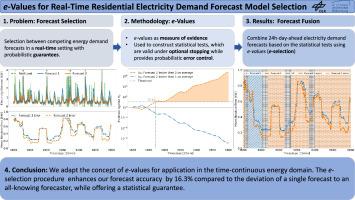基于e值的连续时间住宅用电需求预测模型选择
IF 7.1
2区 工程技术
Q1 CONSTRUCTION & BUILDING TECHNOLOGY
引用次数: 0
摘要
随着预测技术的不断增加和基于预测的业务日益重要,特别是在快速发展的能源部门,选择最有效的预测模型已成为一项关键任务。在这种情况下,一个预测模型相对于它的替代方案的优势,一般来说,如果有的话,只在平均情况下(随着时间的推移或跨场景)保持,并且模型选择通常会导致一个单一的静态决策。相反,为了在能源和建筑环境中实现实时决策,我们引入了基于e值的决策概念,该概念最近在统计领域获得了广泛关注。我们获得了连续时间的、方法盲的、数据依赖的决策规则,这些决策规则根据预测误差的传入信息进行决策和修正。尽管如此,它们仍然提供统计保证,包括在整个时期内固定的决策风险。我们通过开发一种简单的持久性方法,将e值的使用扩展到没有程序明显优于其竞争对手的情况下,该方法动态地组合输入预测以生成新的融合预测。为了证明我们的方法的性能,我们将其应用于基于不同人工智能模型的电力需求预测。我们的电子选择程序提高了我们的预测准确度16.3%的偏差相比,一个单一的预测到一个全知的预报员。此外,它还提高了动态环境下预测的可靠性,为能源部门的实时决策提供了有价值的工具。本文章由计算机程序翻译,如有差异,请以英文原文为准。

e-values based continuous-time model selection for residential electricity demand forecasts
With the growing number of forecasting techniques and the increasing significance of forecast-based operation, particularly in the rapidly evolving energy sector, selecting the most effective forecasting model has become a critical task. In this context, the superiority of a forecasting model over its alternatives will, in general, hold—if at all—only on average (over time or across scenarios), and model selection typically results in a single static decision. Instead, enabling real-time decision making in the energy and building context, we introduce the concept of -values-based decisions, which has recently gained massive attention in the field of statistics. We obtain continuous-time, method-blind, data-dependent decision rules, which take and revise their decisions along with the incoming information of forecast errors. Nevertheless, they still provide statistical guarantees, including a fixed decision risk over the whole period of time. We extend the use of -values for times where no procedure is significantly superior to its competitor by developing a simple persistence approach that dynamically combines input forecasts to generate new fused predictions. To demonstrate the performance of our method, we apply it to building electricity demand forecasts based on different artificial intelligence-based models. Our -selection procedure enhances our forecast accuracy by 16.3 % compared to the deviation of a single forecast to an all-knowing forecaster. Additionally, it improves the reliability of the forecast in a dynamic environment, offering a valuable tool for real-time decision-making in the energy sector.
求助全文
通过发布文献求助,成功后即可免费获取论文全文。
去求助
来源期刊

Energy and Buildings
工程技术-工程:土木
CiteScore
12.70
自引率
11.90%
发文量
863
审稿时长
38 days
期刊介绍:
An international journal devoted to investigations of energy use and efficiency in buildings
Energy and Buildings is an international journal publishing articles with explicit links to energy use in buildings. The aim is to present new research results, and new proven practice aimed at reducing the energy needs of a building and improving indoor environment quality.
 求助内容:
求助内容: 应助结果提醒方式:
应助结果提醒方式:


